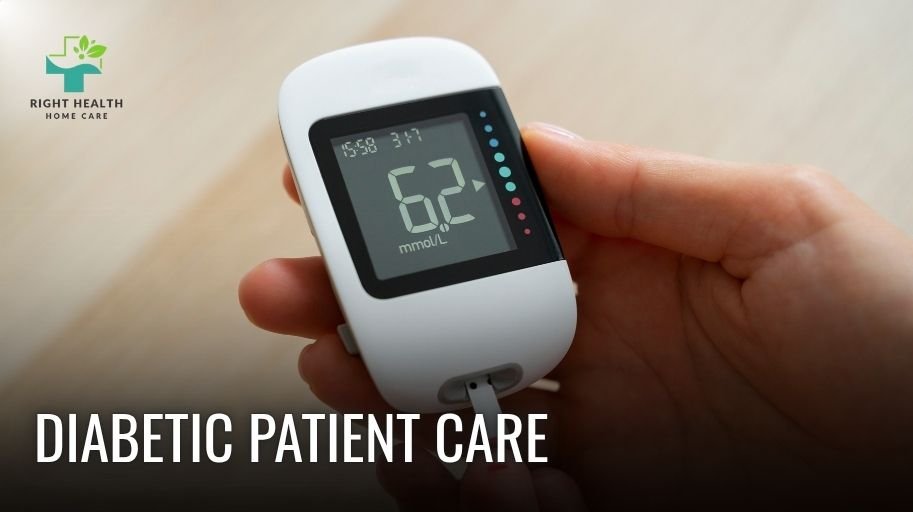A Comprehensive Guide for Families and Caregivers on At-Home Diabetic Patient Care
Diabetes is a chronic condition that affects the body’s ability to regulate and process blood sugar, or glucose.To avoid complications including kidney failure, nerve damage, heart disease, and eye issues, effective care is essential. To help diabetics maintain stable blood sugar levels and improve their overall quality of life, home care is just vital as medication and doctor visits. Whether they are elderly parents, family members, or just diagnosed loved ones, this article covers crucial techniques and suggestions for giving diabetic patients at home care.

Identifying the Diabetes Type
Identifying the kind of diabetes your loved one has is essential when creating a care plan:
- Insulin production is impaired in people with type 1 diabetes. Daily insulin shots are required for patients.
- Type 2 diabetes occurs when the body either doesn’t use insulin effectively or doesn’t produce enough of it.Oral medicine and lifestyle modifications are frequently used to control it.
- Gestational diabetes linked to pregnancy usually goes away after birth.
Keep an eye on blood sugar levels
For successful control of diabetes at home, constant surveillance is essential. Blood sugar levels can vary caused by food, stress, illness, and medication.
Advice on how to evaluate blood sugar levels:
- Utilize a reliable glucometer and keep it clean.
- Record readings in a logbook or mobile app.
- Check your blood sugar levels as instructed by your doctor—typically before meals, after meals, and before going to sleep..
- Keep an eye out for symptoms of hypoglycemia, or low blood sugar, including lightheadedness, perspiration, and confusion.
- The symptoms of hyperglycemia, or elevated blood sugar, include thirst, frequent urination, and low energy.
Dietary Management and Nutrition
Blood sugar levels must be controlled with a balanced diet. Diabetes patients should eat a diet high in fiber, lean proteins, healthy fats, and complex sugars and stay away from processed and sugary foods.
Nutritional recommendations for at-home care:
- Make your meals consist of clean vegetables, low-glycemic fruits, and nutrient-dense grains.
- Avoid white bread, sugary soft drinks, and fried snacks.
- To prevent sugar surges, make sure your meals are scheduled regularly.
- To develop a customized food plan, speak with a dietician.
Physical activity and exercise
Exercise reduces blood sugar and improves insulin sensitivity. Routines at home can be easy and productive.
Activities that are suggested:
- 30 minutes a day of vigorous walking.
- Yoga or little resistance training.
- household tasks to maintain an active lifestyle.
Management of Medication
Many diabetes patients, particularly those in their later years, need to take insulin or oral hypoglycemics daily.
- Advice for caretakers regarding medications:
- Keep a daily medication log.
- To prevent missing dosages, use pill organizers or set alarms.
- Do not change your insulin dosage without first consulting your doctor.
- Store insulin in a refrigerator to keep it safe and effective.
Skin and Foot Care
Diabetes damages nerve cells and weakens blood vessels, especially in the foot. If not treated, even little wounds can become severe illnesses.
Home care routines for healthy feet and skin:
- Every day, wash and pat dry your feet, looking for any cuts or pain.
- Avoid moisturizing in the space between your toes.
- Make sure the shoes fit correctly.
- Even at home, you should never go barefoot.
Emotional and Mental Well-Being
Having a chronic condition may give rise to stress, anxiety or even depression. A loving setting at home is crucial.
- Advice for providing emotional support:
- Promote candid discussion of emotions and anxieties.
- Include the patient in decisions about their treatment.
- Honor little accomplishments, such as better reading or weight loss.
- If you see symptoms of depression, think about getting professional treatment.
Being Ready for Emergencies
Be ready for unexpected increases or decreases in blood sugar.
Tips for emergencies:
- Have a sugary snack or glucose pills on hand.
- Teach your family how to handle hypoglycemia.
- Keep a list of prescriptions and the doctor’s contact information handy.
- Recognize when to get medical assistance.
Conclusion
Families and caregivers who adhere to diet, medication, physical activity, and emotional well-being can have an important effect on the long-term health of their loved ones. Diabetes care at home demands hard work, motivation, and an in-depth knowledge of the condition. If the proper strategy is employed, diabetes can be successfully controlled while leading a full, healthy life.

